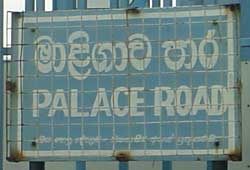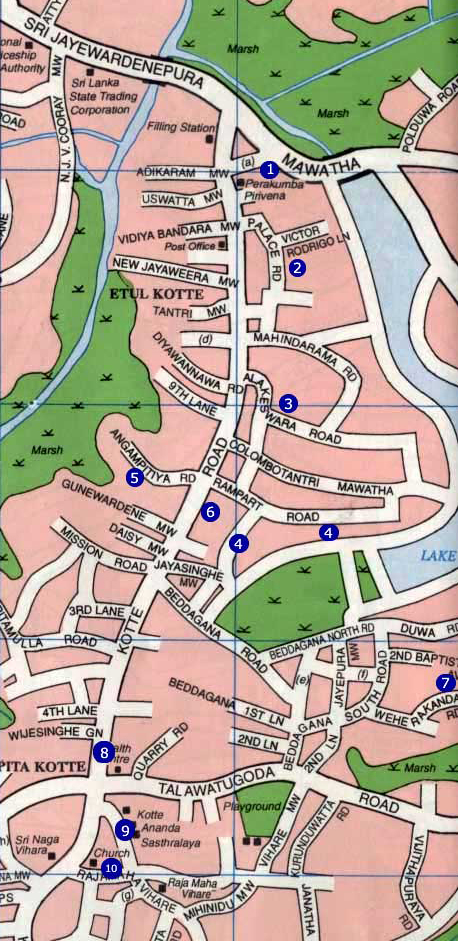 Traveling down Kotte Road, the next left turn leads one down the Palace (Maligawa) Road. Unfortunately the name board you find at the top of this lane will be the closest thing you will ever come close to a Royal Palace. No trace of the royal complex consisting of the royal palace, royal courts, ponds and the temple of the tooth (dalada maligawa) remain today.
Traveling down Kotte Road, the next left turn leads one down the Palace (Maligawa) Road. Unfortunately the name board you find at the top of this lane will be the closest thing you will ever come close to a Royal Palace. No trace of the royal complex consisting of the royal palace, royal courts, ponds and the temple of the tooth (dalada maligawa) remain today.
In it’s day, the palace complex has consisted of a three storied palace building and a three storied building for the tooth relic, the symbol of the sovereign. Repeated invasions led to the destruction and pillage of these buildings. What ever was left has been built over now. Only a trained archaeologist will be able to point to any remains or the probable positions, and for that we refer the book on Kotte Fortress by Prasad Fonseka.
 |
| Map from Sir Paul E Peiris’s book on Kotte, showing the location in relation to the outer defenses. |
The place that was occupied by the Dalada Maligawa, has been used by the Portuguese to build a church. This too has been destroyed later by the Dutch, who took the materials to build their own church in Colombo. Artifacts found from this place are displayed at the Kotte Archaeological Museum. The picture below shows the probable present day location of the Palace Complex at the bottom of Maligawa Road. The Palace has been situated past this, up to around and near the land occupied by the factory. The rear entrance to the palace has been from what is now known as the school lane, off Mahindarama road (second picture).


The ‘Fonseka’ who wiped clean the remains:
An interesting episode concerning the destruction of the remains of Kotte by a de Fonseka, is narrated by Prasad Fonseka in his excellent book, ‘Kotte: The Fortress (p69). The British Government has transferred the ownership of the land called Pasmahalpayawatta or maligawatta, by about 1885 to one Mudaliyar de Fonseka. This was the main area of the ancient Kotte where the Palace, royal courts, the Temple of Tooth relic, the royal stores and the remains of the Portuguese church built after demolishing the Dalada maligawa, were situated. As a result this area was not occupied by settlers.
The relevant paragraphs from the 1907 Archaeology report is reproduced below. The reference to Mudaliyar ‘de Fonseka’ is slightly incorrect as the paper identifies the person as a Muhandiram J. Fonseka.

An “off chance” for the Archaeological Survey Department to “sample” the antiquities of Kotte unexpectedly occured in 1909, in the offer – too belated to result in much benefit archaeologically, but accepted as pro tonto generous – by a land owner of Kotte (J. Fonseka, Muhandiram), who had for some time been conducting undirected amateurish conservation on his property.
The Muhandiram was finally induced by the Archaeological Commissioner to present to the Colombo Museum any sculpture in his land still remaining undisposed of and considered by the government worth preserving.
The Museum has thus tardily acquired about a dozen broken sculpted pillars, &c., from Royal or Temple, edifices of Jayawardhana Kotte of the 15th century.
Not a single carved stone is perfect. Among the most beautiful, but all too fragmentary, carvings is part of a fine kirtti mukha face, with a lotus and buds depending from the mouth This must once have formed the crown of a magnificent granite makara torana over the entrance to the Palace or some important Vihare.
Regarding an oblong ruin which had been uncovered in the Muhandiram’s land, Mr. W. M Fernando of the Archaeological Survey furnished a brief report.
As directed I proceeded from Anuradhapura to Colombo, and visited the newly excavated ruin in Fonseka Muhandiram’s land called “Maligawatta” at Kotte
After a close inspection, I sketched and measured the carved stones. It is a great pity to see the damage done in the excavation of such an interesting ruin by unskilled coolies employed by the inexperienced owner. The ruin has been dug to the very bottom; and foundation stones and kabok bricks are piles in great heaps. It is very difficult to describe the building, or to say what it was, and to give the position of the entrance. Judging from the carved stones and the cabook bricks, I think it was a Vihare, and that it’s roof was supported by octagonal curved pillars, like those of the Magul Maduwa at Kandy.
The walls were built of cabook bricks, plastered with lime mortar 1 1/2 inch to 2 inch thick. The main entrance was probably once under a stone carved makara thorana. A piece left shows the makaraya with a lotus flower and buds hanging from the mouth. The doors and window frames were ornamented with lions, peacocks, and lotus wreaths. Although in fragments, it is worth while securing these carved stones for government. The inside portion of the ruin is not dug. There may yet be more carved stones to be found if the center part is excavated. The ruin is not sufficiently excavated to measure accurately, but I would put it’s dimensions at about 100 feet by 50 feet. It is an oblong building.
Towards the identification of this ruin Mr. E. W. Perera has kindly favored the Archaeological Commissioner with the following remark.
I have visited the “ruin” referred to in Mr. Fernando’s Report. It is one of the ruins in Maligawatta mentioned in the appendix to my “Alakeshwara” paper. It is popularly known as the site of the Palace of Don Juan Dharmapala. On its ruins a Portuguese Church was erected of which the bell is now hung in the belfry at Kayman’s Gate. My own view is that it is the Magul Maduwa of Sri Parakrama Bahu VI, described in detail in contemporary poems.
Footnote: The correspondence on the subject is not edifying. The owner expected Rs. 100 for every cartload of the fragmentary stones. The Museum declined, naturally. Ultimately, after futile inquiry whether the Government would pay for his experimental digging, the Muhandiram accepted the suggestion (A.C. No 636, Sept 13, 1909) to “present all the carved stones unearthed to the Government unreservedly, provided that it undertakes to transport any stones it may care to possess from Kotte to the Colombo Museum.” On this fair offer the Director of the Museum took action and several valuable pieces of sculpture are now housed at the Museum.
My thanks to Prasad Fonseka who shared the relevant pages from the 1907 Archaeological report with me.
